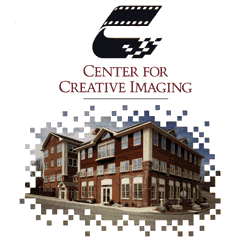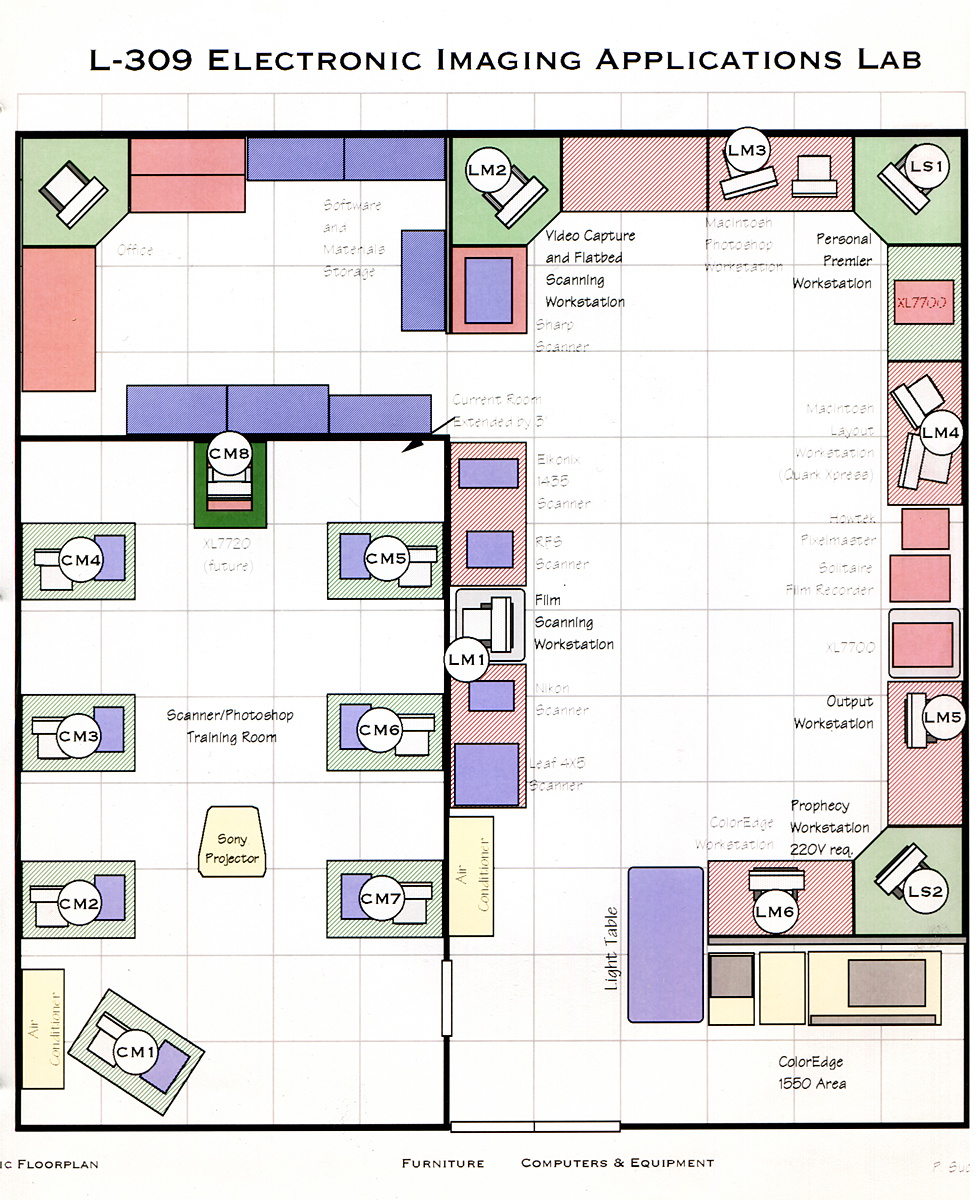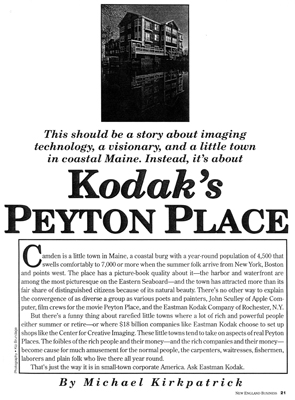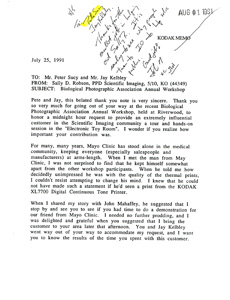

1991 - A Promotion, the Center for Creative Imaging, and stuck at MEC |
 |
New Position with PPD as first digital imaging instructorI finally made move to PPD, and was promoted to a professional wage grade. I was now located on the third floor of the Lab building at MEC. It was the same building, where I had started out as a janitor in 1975. Coincidently, Kodak's Marketing Education Center was founded by my father, Jim Sucy, in 1971. He was the first director of instructional programming at MEC for a number of years before becoming Manager of Government and Eduction Markets in the late 70's. I discovered I wouldn't be moving to Maine anytime soon. They wanted me to setup another training facility similar to the one I configured for CCI. The gave me a space and told me to start laying it out and ordering the equipment. I'd be doing training of Kodak reps at MEC, rather than at CCI as I had proposed. Mark and I had discussed training our reps alongside the professional and amatuer attendees at CCI. We felt it would give our reps a better idea of what customers were doing and a fuller understanding of their business needs. Not to mention building relationships. Management nixed this. Camden was too far from any major airport and they did not want to pay the travel expenses for the reps to go there. L309 Electronic Imaging Lab
I went to work designing the new lab. Using MacDraw II, I made a layout of the bare room, using the 3 foot grid the moveable wall system was built on. Then, I divided the space into three, a classroom with six workstations and an instructor workstation, A lab area with an area for the ColorEdge 1550 scanner/copier, film & flatbed scanner areas, film recorder/printer area, as well as Premier and Prophecy workstations. All the latest electronic imaging hardware from Kodak and from other manufacturers as well was available to me. The last space was an office in the back for myself. The MacDraw floorplan I gave to building services consisted of the basic floorplan on an XL thermal print (seen above), then there were transparent layers for, wall layout, electrical layout, HVAC, furniture, computers & equipment. The building services people at MEC were quite impressed with the specifications I provided. It made getting the room ready go a bit quicker, even though they still required transfering it to blueprints. The final result looked pretty much the same. It was like Christmas all over again when stuff started arriving. They sent me to be trained on the ColorEdge 1550 copier, which arrived early on. Amazing color copier/scanner could be hooked up to a PC for scanning. There was a Prophecy system which was Kodak's entry level color image editing for desktop publishing systems. Never got the feel for the software, so used it little. There was a Matrix Film Recorder, with up to 8" x 10" backs, a Leaf 4x5" Scanner, a Premier image editing workstation, a Sharp color scanner, an RFS35, a couple of XL7700's, and a bunch of Mac IIfx's for the lab and the classroom. The classroom had six workstations with seating for two, an XL7720 with Mac at the back of the room, a trainer's workstation at the front which was connected to a large Sony projector hung from the ceiling. I had a partner in crime by now to help me get everything setup and working. Jay Kelby, my first lab assistant and a recent RIT grad, was great at hitting up our boss John for new equipment, so I began sending him to ask for new stuff for the lab. Training was my job now, but I'd become the go to problem solver on printer issues, imaging system issues and Mac issues, so I still kept my hands in the technical side. I'd work with product development on new products providing field and personal feedback to improve the customer experience. This didn't always go over so well with my new boss. Center for Creative Imaging Opens in CamdenIn May, I was invited up to Camden for the grand opening of CCI and the "walk-through" with some upper management types. It was astonishing, in my wildest dreams I never envisioned a school like Ray had built. Converting an old mill into a state of the art digital training facility must have been tremendously expensive. There was a good sized gallery on the ground floor along with a cafe with outdoor seating by the river, offices, two floors of classrooms above, and as I discovered climbing around the building, two luxury apartments were in the progress of being built in the "attic". One was two stories and overlooked the river, it looked like it was going to be very nice. The smaller apartment later became a space for instructors and staff. The uppper management types were not happy with the extravagance . However, that was just part of the scandal that would involve the school. You can read about it in the article below which kinda recaps it. 
Shortly after the opening, Mark resigned and returned to Rochester. He wouldn't tell me much about why, other than telling me that it was probably not wise to be there for awhile. The shit eventually hit the fan, but it was kept pretty quiet. As it turned out, I never would have an opportunity to teach there, but I would be doing plenty of instructin' elsewhere. Later, that month we learned that Ray DeMoulin, Joan Rosenberg, the new director, and her assistant had been fired, exact reasons were never given. I heard part of the ruckus involved the CCI's use of a mailing list belonging to the Maine Photographic Workshops. Here's an article in the Bangor Daily News. Training RepsOne part of the plan Mark and I had put together was for the field personnel to be trained alongside customers in order to learn more about their workflow. This part of the concept got shot down for whatever reason, I heard is was the travel expense, but I think there were other reasons. CCI was to get the high profile clients, and MEC would handle internal training. That meant me. My role was to train the TSR's and other personnel on the basics of digital imaging and how to use and even demonstrate our products. Often this was a difficult and frustrating task. For most this was a whole new world, computing. With some individuals, I first had to start by teaching them how to use a mouse and the computer. Getting through these basics was often too tedious and time consuming for others who did have experience. Many of the reps didn't want to be there in the first place, it was time out of their district during which they weren't earning commissions. While I'd be working with one group, a few often disappeared from the classroom to find a phone. There were also a good number who caught on quick and became quite enthused by the possibilities digital imaging offered. Still, probably the toughest classrooms I'd ever had. Every now and then, the occassional college photo or printing group would come through on a tour, and this was usually a treat. We would give them a basic tour and show some of the samples we have, maybe take a photo and print it out. They were much more interactive asking lots of questions and left pretty excited. Those types of interactions always gave me a boost. The Lab and Dog and Pony ShowsA good portion of the job was showing off Kodak digital equipment in my lab to visitors. We called them "Dog and Pony Shows" because we'd drag out the equipment & some samples, and get ready to put on a show for the visitors to MEC. We had a large $20 bill printed on the copier, I had samples of retouching,and compositing work I'd show, many of my digital images had been framed and were hanging on the walls of the lab, all to try and give a quick overview of what was possible. The lab was also a place where engineering teams could come to troubleshoot connectivity and other isssues with new products. This, I felf, was one of the more important skill sets that I provided. My system and imaging application knowledge from my previous roles had made me one of the top Mac system troubleshooters within the company. It started me thinking about creating a new lab specifically for this purpose. Convincing the UnconvinceableA great many top clients were brought into MEC by PPD to either train them or impress them. Not everyone was buying the new digital products however. Many felt they would never equal the quality of film. Some states however, were passing new laws banning photochemical wastewater so there were many that HAD to convert. A role Jay and I sort of stepped into, was convincing and assuring these clients. Many of the district managers would often bring one of these reluctant clients down to our lab for a private demo. Below is a sample of the many letters I received over the year. 
|